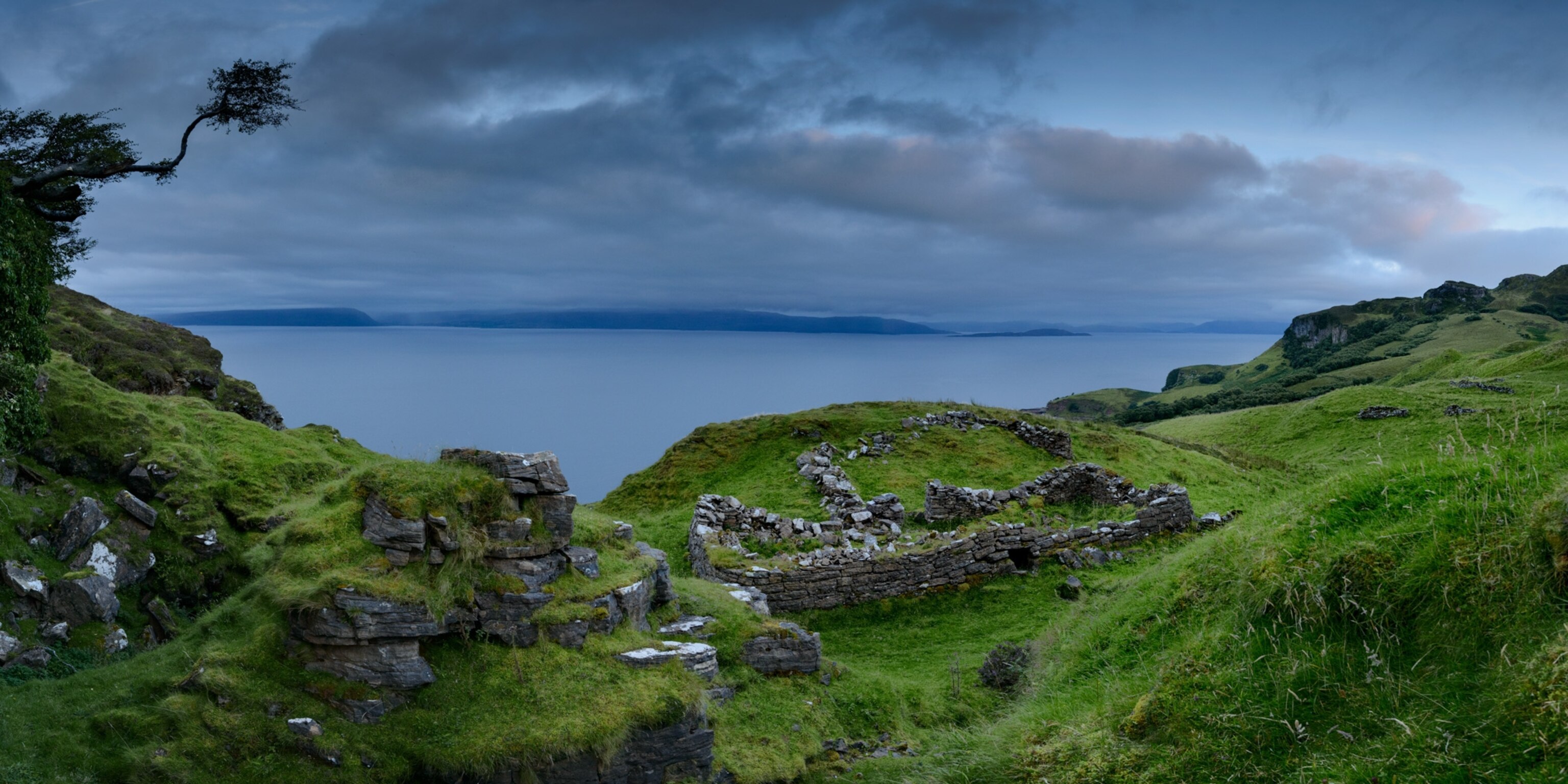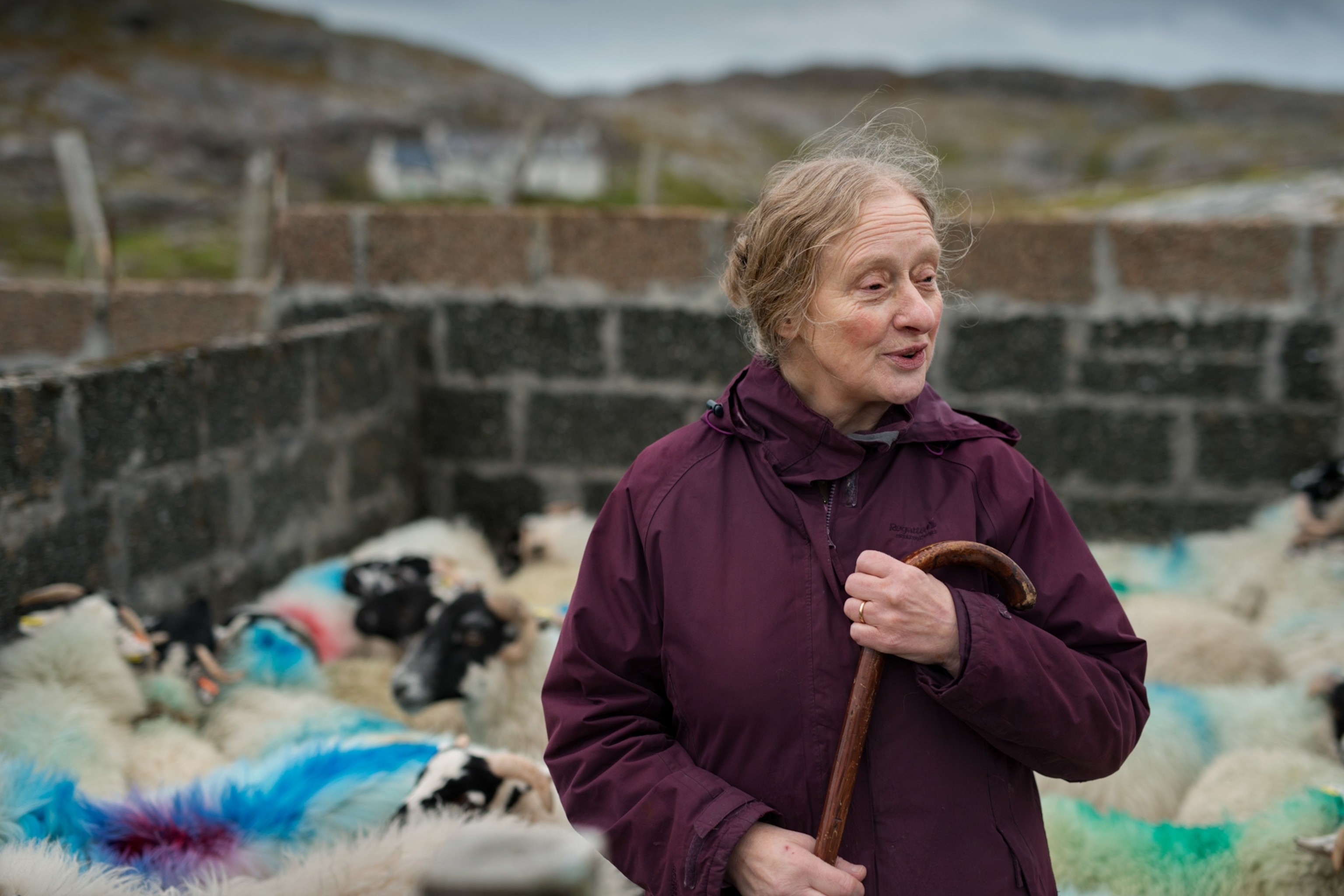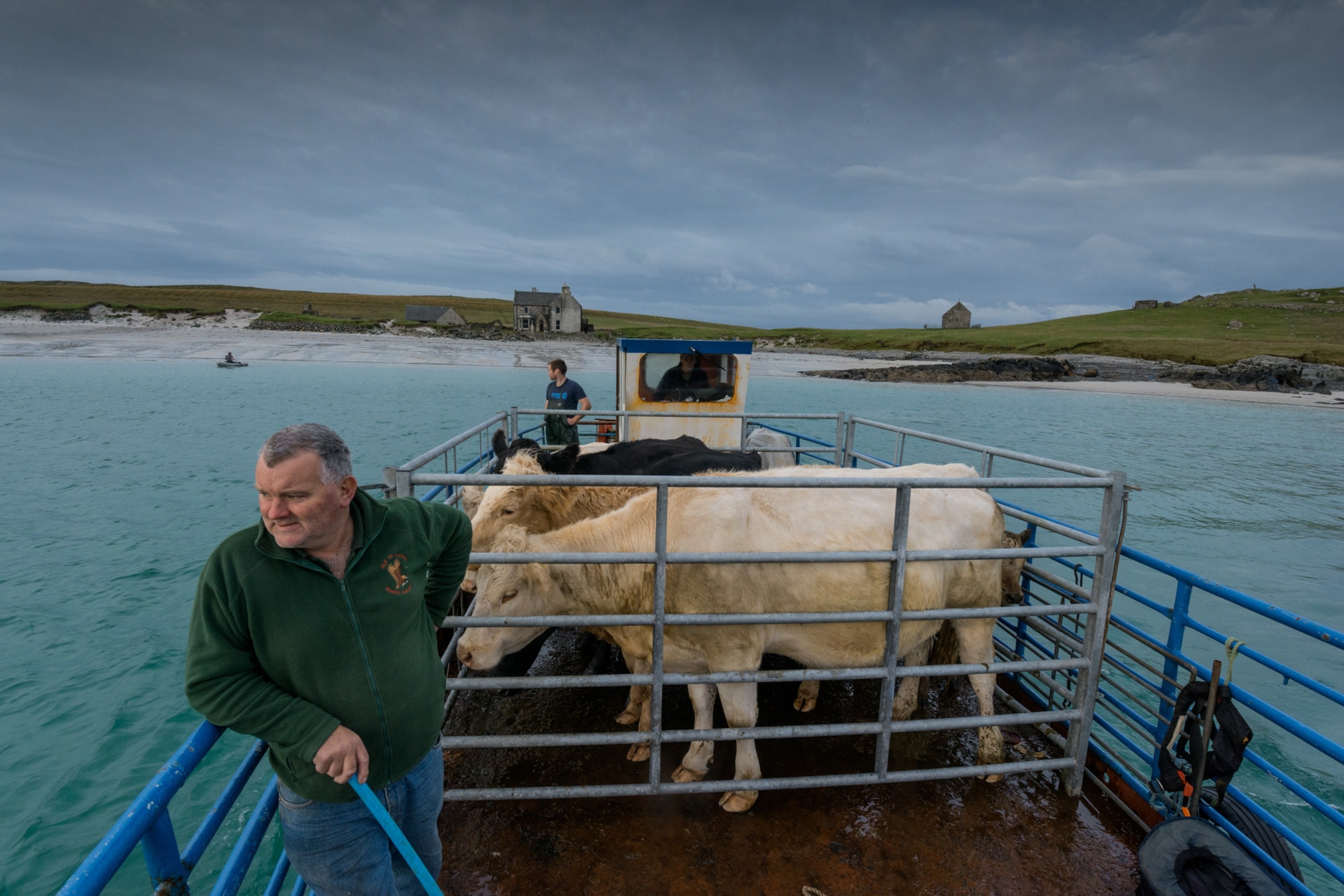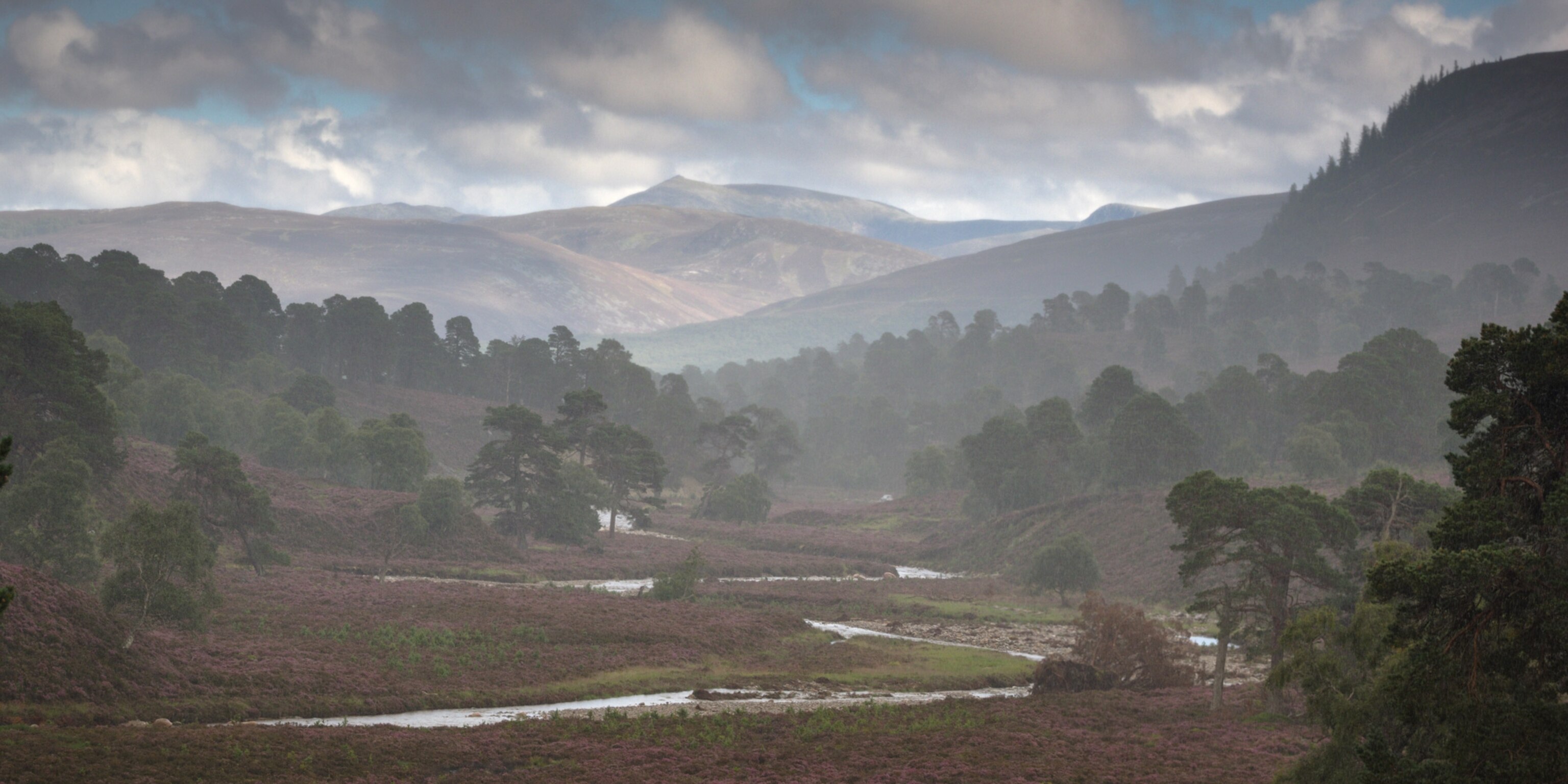
What Will Become of Scotland's Moors?
The future of the nation's signature landscape is murky amid debates over class, culture, and nature.
At exactly 6 p.m. on July 30, 2015, in Kingussie, Scotland, George Pirie, the agent acting on behalf of Eric Heerema, a Dutch entrepreneur, took possession of Balavil Estate from Allan Macpherson-Fletcher, its former owner. The sale, worth about five million pounds ($6.3 million U.S.), meant that the 7,000-acre property—with its gray stone 18th-century manor designed by Robert Adam, rolling moors, three-mile beat of the River Spey, and Sarah the resident ghost—would no longer be part of a family legacy spanning 225 years.
“It was a great way of life, but it was time,” Macpherson-Fletcher said later, sipping a whisky in the sunroom of a renovated crofter’s cottage in a corner of the estate he’d held back for himself and his wife, Marjorie. Macpherson-Fletcher, a warm, genial, white-haired man with round tortoiseshell glasses, dressed in madder-hued trousers and a dark blue cardigan, sounded relieved.
He was 65, ready to retire. His children, “wisely,” Macpherson-Fletcher said, had no interest in taking over. The expense of upkeep was depleting of heart and wallet. “The fastest way to lose money is to own a Highland estate,” he quipped. Finally, the Scottish Parliament was about to push through a land reform bill that threatened to make ownership of such estates more costly and difficult—a plan shaped in part by long-held tensions over class and debates about the future of the moors, Scotland’s signature landscape.
For Macpherson-Fletcher, it was time to ring down the curtain.
In preparation for the new owners, the house had been stripped down to its hardwood floors and wainscoted walls. Down came ancestral portraits; closets were emptied of coats, breeks, caps, and waistcoats in the blue, tan, and brown estate tweed. Into storage went the glass-eyed trophy heads that hung on walls (stags, gazelles, two Cape buffalo, game birds), the mahogany dining table, silver meat domes and branched candelabras, Oriental carpets, the sterling service for 30 engraved with the Macpherson crest and motto, “Touch not the cat bot a glove” (translation: Don’t mess with me).

Instead of a sporting estate—a quintessentially British institution where clients pay dearly to roam the moors to stalk red deer, shoot grouse, and fish for salmon—Balavil would become a family residence. The manor, said the buyer’s wife, Hannah Heerema, would be a place “for the children to spend time.” (Last May the owners filed an application, pending as of this writing, to turn the farm buildings into a visitors center with a café, events facilities, and a parking lot with about 140 spaces for cars and buses. Communities nearby, unpleasantly surprised about the turn toward the commercial and concerned about the detrimental impact on their villages, objected.)
After the closing, as if to underscore the end of a chapter, agent Pirie, who had been doggedly trailing Macpherson-Fletcher to ensure the deadline was met, drilled the garage door shut to secure the premises. What a shame that there were swallows nesting inside the garage, trapped as an unintended consequence of the sale.
“Poor birds,” thought Allan Macpherson-Fletcher, the former Laird of Balavil.

Balavil sits in the Scottish Highlands, bracketed between the Spey and the Monadhliath Mountains. Six thousand of the estate’s 7,000 acres are moorland—a unique landscape whipped by the same gale-force gusts of economic, social, and political change that helped sweep the estate into the arms of a foreign buyer. (With the drop in the value of the pound after the United Kingdom’s vote to leave the European Union, acquisition of Scottish estates by foreign money is likely to accelerate. International buyers snapped up half of the 16 estates sold in 2015 and 2016.)
A moor is a close-shaven landscape of shrubs and grasses clawed at by wind, minimalist in feel. Think abstract art: blocklike swaths of color in a muted palette of ocher, sienna, and charcoal, with accents—depending on season and terrain—of sulfuric yellow (bog asphodel), maroon (lichen), and in late summer, a royal cloak of purple heather. The term incorporates the drier heath of the Highlands, as well as the wetter landscapes of blanket bogs in the more poorly drained regions of the country. Seventy-five percent of the world’s heather moorland is in the United Kingdom, most of it in Scotland.
A moor is also the bleak backdrop of gothic literature and Hollywood epics: Emily Brontë’s Wuthering Heights, Arthur Conan Doyle’s Hound of the Baskervilles, Mel Gibson’s Braveheart. Above all, it is the iconic headliner of Visit Scotland tourist brochures. In a government survey, respondents identified a heather-carpeted moor, a loch, and an artfully placed red deer as the country’s archetypal landscape. National identity balances on the tip of a landscape tradition. For Americans it’s the Wild West; for Australians, the outback. In Scotland the mist of myth envelops the moors. The landscape of a moor, which looks as if it has always been there but hasn’t, “is wild but not wilderness,” explains biologist Adam Smith, director of the Game and Wildlife Conservation Trust in Scotland. To remain heather moorland, it must be managed by selective, periodic burning to prevent forest from reclaiming the terrain.
Because of overgrazing by deer and sheep, invasion by bracken, and the setting aside of land for forest, Scotland has lost more than 25 percent of its heathland since World War II—but whether that loss is cause for concern depends on your point of view. To step onto a moor is to sink into a bog of contention, resentment, and righteousness. Not everyone agrees, but scientists such as Smith argue that moors are among the most biologically diverse habitats in Britain, populated by a multitude of birds: curlews, golden plovers, lapwings, and merlins. There are economic benefits—tourism, most of all. And environmental ones: Wet moors, those with peat bogs, are effective carbon sinks and thus mitigators of climate change.
A significant percentage of moorland is managed specifically for grouse shooting, but a passionate contingent believes that such land could be put to better use. David Read, an emeritus professor of botany at the University of Sheffield, for one, thinks some of the land would be better off more thoughtfully planted with Sitka spruce for lumber. “Heather is unproductive,” he says. If there were more spruce, “at least Scotland wouldn’t have to depend on lumber imports.”
Others—such as Mike Daniels, head of land management at the John Muir Trust, a conservation group—would allow moorland to revert to its natural state, a process known as rewilding. “What would you rather see,” Daniels says, in tones that would strip paint off a wall, “a golden eagle in wilderness or toffs shooting grouse?”

The trip wire of ownership adds yet another layer to the debate. According to land reform specialist Andy Wightman—who has spent 20 years combing through deeds, records, and maps to research landownership—just 432 people own half the privately held rural land in Scotland.
“The super-rich have always been able to buy and manage Scottish land, no questions asked,” says Lesley Riddoch, a land reform activist who believes that large country estates are emblematic of inequities and an affront to Scottish democracy. “For centuries lairds have run sporting estates, sometimes the size of small countries, without local input—evicting tenants here, tolerating crofters there.” Riddoch would like to see the land broken up into affordable parcels and made available to young families.
The Scottish sporting estate is elite by tradition. In 1852 Prince Albert bought Balmoral Castle, in the Aberdeenshire Highlands, for Queen Victoria. The royal imprimatur made going to Scotland downright chic. Royals and men of means decamped to drafty manors in summer for sport and other diversions. Wealth from the industrial revolution and newly opened railway lines from London to Scotland made it possible to pop into Scotland for a few weeks of shooting. The upper class fell into a tartan swoon.
The Balmoral effect persists. In the early 1990s, Mar Lodge, a 72,000-acre estate near the queen’s property, now owned by the National Trust for Scotland, belonged to the billionaire husband of a former nude model, who had hoped to be friends with the neighboring royals.
Fat chance.

On June 22, 2015, a Scottish government bill was introduced that, among other things, called for reinstating a tax on sporting estates and easing the way for the community purchase of estate land, thanks to a government fund.
“It’s an antique structure that has to be changed,” said Michael Russell, a member of the Scottish Parliament and the committee that evaluated the bill. He spoke of fat cats tone-deaf to public interest, like the Australian hedge fund owner who proposed building a golf course on the island of Jura—just for his buddies—before community pressure effected a change of heart. “We have to take some radical action. We should have done this long ago,” Russell said.
Besieged estate owners acted like stags at bay. “A Mugabe-style land grab,” Lord Astor wrote in the Spectator, deriding the bill. “Tartan Stalinists: Forced sales of country estates … Contempt for the wealthy,” howled the Daily Mail. The political windstorm affected the sale of Balavil, which languished on the market for two years, its asking price ultimately cut by two million pounds. Buyers, said Robert McCulloch, a partner in real estate broker Strutt and Parker, were wary of the uncertainty surrounding land reform, Scottish independence, and the specter of higher taxes. The bill passed in March 2016.
Nine “guns”—as members of a shooting party are known—gathered in front of the manor house at Rottal Estate, in the Angus Glens, along the South Esk River, on a clear September day. The property, once owned by the Earl of Airlie, had been sold in 2005 to Hertfordshire businessman Dee Ward, who had invited his friends for a driven shoot: the sporting equivalent of Kabuki theater, a ritual with distinctive costumes and customs. One dresses for grouse. Ward wore his estate tweeds with a tattersall shirt and wool tie. It shows respect for the bird, he explained. “We are shooting red grouse,” he reminded his guests. “Snipe are allowed, but please don’t shoot black grouse or hares.”
Rottal, a classic sporting estate, is managed for grouse shooting, a controversial pursuit often attached, fairly or not, to words such as “elite,” “snob,” and “toff.” A “driven shoot” is the Rolls-Royce of a noble sport, if you are a devotee, and perhaps a ridiculous pastime if you are not. Those in the shooting party that day were friends of the owner, but for paying guests, a day on the moors can cost £750 (about $935) or more per “gun.” (The client may take home two birds, called a brace; the owner sells the rest to the game dealer.) Throw in accommodation—at Inverlochy Castle in the West Highlands, for example, you may book a suite for £695 (about $870) a night—add meals, tips, a J. Purdey & Sons shotgun with a Circassian walnut stock and rose-and-scroll engraving ($80,000 and up), and you see why the sport tilts in the affordability direction of hedge fund directors and other masters of the universe.
In a driven shoot, beaters—people waving flags—sweep through the moors in a line to flush birds toward the guns. Unlike a pheasant, which flies straight and high and presents a fat, complacent target, the red grouse—Lagopus lagopus—flies fast and low, like a feathered dart on an erratic trajectory. Afterward dogs retrieve the birds.

The dispute over driven shoots on the moors is more bare-knuckle boxing match than debate. “A practice pursued by the few to the detriment of the many,” writes Mark Avery, whose petition to ban the sport in the United Kingdom attracted 123,000 signatories last year. “Maximizing the number of grouse means treating the moors as if they were giant chicken runs,” columnist George Monbiot argued in the Guardian.
The other side argues, with equal vehemence, its own version of biodiversity and economic benefit. “We run a grouse shoot with strong conservation roots. Heather-clad moorlands are one of the rarest habitats in the world,” says Robbie Douglas Miller, owner of the Hopes, an estate in the southern part of Scotland known as the Borders. “To protect and enhance, it takes a lot of time and money. Grouse moor management is the only use for upland that does this.”
The economic argument is backed up by a survey sponsored by the Game and Wildlife Conservation Trust that says grouse shooting supports 1,072 jobs, provides £14.5 million ($18.3 million) in wages, and adds £23.3 million ($29.5 million) to Scotland’s gross domestic product.

But rewilding advocate Mike Daniels counters that those numbers are relevant only to those who regard nature as a commodity. “You could say cheekily that if economics was the only criterion as the sole justification for a land use, then presumably you could make a strong economic case for slavery or bear baiting.”
“The truth of the matter is that if you think hunting is wrong, you will not be swayed by any argument,” says Tim Baynes, director of the Scottish Land and Estates Moorland Group, which represents owners.
The Game and Wildlife Conservation Trust’s Adam Smith quietly says this of the grouse-shoot dustup: “Moors are cultural landscapes where conflict and conservation sit side by side.”
The battle carries more than a whiff of class divide. “I wish,” sighed estate owner Robbie Douglas Miller, his frustration palpable, “that people paid more attention to how the land is managed rather than who owns it.”

So let’s consider management. Roy Dennis, an ornithologist and wildlife consultant, abhors moors managed for grouse. “Moors are as man-made as the olive groves in Italy,” he says. “Most areas that now have moors were once forest.”
Dennis consults for Swedish-born philanthropist, publisher, and heiress Sigrid Rausing, owner of Coignafearn, a 40,000-acre estate in the Monadhliath Mountains, who hired him to restore the land to a natural state. He drove me out to see the restoration in progress: fences that kept deer from eating trees and shrubs and the resurgence of birch, Scots pine, wild cherry, willow, and rowan trees with their scarlet berries. A golden eagle circled in the sky.
“The problem,” he said, “isn’t with shooting grouse. It’s the intensification of land used to raise high numbers of grouse that isn’t sustainable.”




There are other estates with rewilding agendas, he said, naming Glenfeshie (owned by Danish billionaire Anders Povlsen), Mar Lodge (National Trust for Scotland), and Abernethy Forest (RSPB Scotland). Landownership is “not just about privilege. It’s about responsibility,” Dennis said.
Ronnie Kippen, head gamekeeper of the Garrows Estate, in Perthshire, disagrees. “I think that rewilding the land is neglect. Do [rewilding advocates] employ anyone?” he asked. In his opinion, managing for grouse is about conservation and jobs, related to the shoot—gamekeepers, beaters, estate staff—and to tourism. “Management of moors brings a livelihood,” Kippen insisted. He drove me around the estate and pointed out an uncommon black grouse, a kestrel, and a meadow pipit, a small songbird. “Who says there is no diversity on a moor?” he demanded.
Now meet Jamie Williamson, a man of unruly eyebrows and a mind that crackles like a Van de Graaff generator, skittering from thought to thought. He manages the Alvie and Dalraddy Estates, a combined 13,350 acres, but carries the title of laird lightly. He drives a truck, wears a plastic digital watch, and runs his property from a desk buried under an avalanche of paper. Williamson, a new breed of owner, acknowledges the past but monetizes the present.

Walk the moors with Graeme Macdonald, Alvie’s gamekeeper, and you will learn something about cultural tradition. Macdonald, a man with a bird’s-nest beard the color of winter, knows every furrow, rivulet, and rise. He knows where stags may be found, which client is to be addressed as “Dave,” who is to be called “Sir,” and when a client misses a shot, will console with exquisite tact: “Difficult bird, Sir.”
Step into the manor library. Note the leatherbound volume with “Alvie Game Book” stamped in gold. Leaf through a diary of life and death in the tally of stag, snipe, and grouse eulogized in ink. “August 22, 1908—107 grouse shot by guns JB Barrington and JFM Lawrence … fine weather.”
The assumption of plenty was misguided, today’s owners admit. In 2015 Williamson canceled grouse shooting. Wet and cold weather in late spring killed insect and plant life; fledglings starved; bird numbers plummeted. The estate lost £50,000.
But grouse shooting represents only 4 percent of estate revenues these days. “The toffs still come,” he says, but “we farm tourists now.” The big money—more than £500,000 ($632,000) a year—comes from renting holiday cabins and camping sites with Internet and TV hookups. Forestry, a zip line, a granite quarry, and a fish hatchery provide additional revenue.
“Being a laird doesn’t make me a villain,” Williamson said. “The criticism of being one of the too few with too much is a distortion.”
For Allan Macpherson-Fletcher, the former Laird of Balavil, all is moot. With the estate sold, there are no more awkward meetings with the bank manager. “In a good year the estate would break even; in a bad, we would lose money, so we had to borrow.” These days the crest on the Macpherson family silver would read: “It is not my problem.”
“As I left Balavil,” Macpherson-Fletcher told me, “I took a final look round, expecting a tear in my eye. And no, there was nothing, because it was just a tired old empty house. All the atmosphere and history had gone with us. What was left was just bricks and mortar.”
On the subject of ownership, the ancients leaned in on responsibility. Aristotle proposed that how one used one’s property was an indicator of virtue.
“We get greedy,” said Alison Hester, a professor and biodiversity scientist at the James Hutton Institute, a research group based in Scotland focused on sustainable use of land and natural resources. The year had turned toward fall. Shadows had lengthened. Soon the soft hills would turn russet; the horizon would be smoke-smudged as gamekeepers on the great estates burned old heather to encourage new growth for grouse to eat.

As part of her dissertation, Hester studied and surveyed heather. She counted the number of shoots in an acre, then the number of flowers per shoot, then the number of seeds—each the size of a pencil dot—per flower. “Heather is absolutely beautiful,” she mused. “It hums with bees. It’s rich with the smell of fresh air and wind that blows your troubles away. As a child, we would go to the moors, fill our mouths with blueberries and listen to the curlews.”
That’s different from woodland, she continued. “In woodland you have the sheltering sensation of trees and the sweet honey smell of birch in spring.” The debate over which is better, she suggested, is an impossible one.
“I think it important to acknowledge up front that one reason for the love of moorland is because it’s a cultural landscape, and not to dress it up as something else. We protect other things for their cultural importance, so we shouldn’t belittle that aspect of it. Perhaps we need to step back and think about the bigger picture.”

Maybe instead of maximizing the population of grouse, you sacrifice some moorland to wildland, she offered. “What do we really want to preserve? Whatever the decision, something is won and something is lost.”
In the service of civilization, meadow yields to olive grove, prairie land becomes wheat field, moor replaces forest. How land is used depends on need, economics, and ownership. But also politics, power—and, Aristotle might say, virtue.
You May Also Like
Go Further
Animals
- These are the weird reasons octopuses change shape and colorThese are the weird reasons octopuses change shape and color
- Why young scientists want you to care about 'scary' speciesWhy young scientists want you to care about 'scary' species
- What rising temperatures in the Gulf of Maine mean for wildlifeWhat rising temperatures in the Gulf of Maine mean for wildlife
- He’s called ‘omacha,’ a dolphin that transforms into a man. Why?He’s called ‘omacha,’ a dolphin that transforms into a man. Why?
- Behind the scenes at America’s biggest birding festivalBehind the scenes at America’s biggest birding festival
Environment
- What rising temperatures in the Gulf of Maine mean for wildlifeWhat rising temperatures in the Gulf of Maine mean for wildlife
- He’s called ‘omacha,’ a dolphin that transforms into a man. Why?He’s called ‘omacha,’ a dolphin that transforms into a man. Why?
- The northernmost flower living at the top of the worldThe northernmost flower living at the top of the world
- This beautiful floating flower is wreaking havoc on NigeriaThis beautiful floating flower is wreaking havoc on Nigeria
- What the Aral Sea might teach us about life after disasterWhat the Aral Sea might teach us about life after disaster
History & Culture
- Scientists find evidence of ancient waterway beside Egypt’s pyramidsScientists find evidence of ancient waterway beside Egypt’s pyramids
- This thriving society vanished into thin air. What happened?This thriving society vanished into thin air. What happened?
Science
- Extreme heat can be deadly – here’s how to know if you’re at riskExtreme heat can be deadly – here’s how to know if you’re at risk
- Why dopamine drives you to do hard things—even without a rewardWhy dopamine drives you to do hard things—even without a reward
- What will astronauts use to drive across the Moon?What will astronauts use to drive across the Moon?
- Oral contraceptives may help lower the risk of sports injuriesOral contraceptives may help lower the risk of sports injuries
- How stressed are you? Answer these 10 questions to find out.
- Science
How stressed are you? Answer these 10 questions to find out. - Does meditation actually work? Here’s what the science says.Does meditation actually work? Here’s what the science says.
Travel
- How to explore the highlights of Italy's dazzling Lake ComoHow to explore the highlights of Italy's dazzling Lake Como
- Going on a cruise? Here’s how to stay healthy onboardGoing on a cruise? Here’s how to stay healthy onboard
- What to see and do in Werfen, Austria's iconic destinationWhat to see and do in Werfen, Austria's iconic destination
- How to get front-row seats to an active volcano in GuatemalaHow to get front-row seats to an active volcano in Guatemala



_4x3.jpg)



